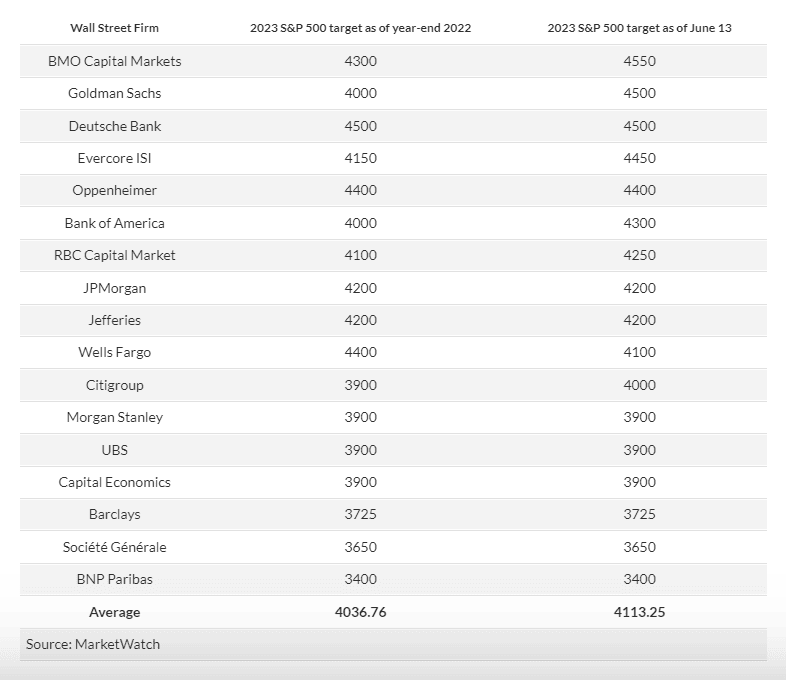Halfway through 2023, Wall Street strategists remain widely divided in their year-end forecasts for the S&P 500 index.
The dispersion has only become more extreme as the large-cap benchmark this month exited from its longest bear market since 1948.
Goldman Sachs strategists Friday lifted their S&P 500’s year-end target to 4,500 from 4,000, citing their unchanged 2023 earnings-per-share forecast which assumes a “soft landing” of the U.S. economy despite the Federal Reserve’s aggressive campaign of interest rate hikes over the past year to fight inflation. They see the potential for market laggards playing catch up with this year’s leaders — megacap technology stocks, while the potential profit boost from AI could help extend the current stock-market rally.
The bullish tone contrasts with their counterparts at Morgan Stanley who just repeated their bearish views on Monday that the bear market is not over as an earnings recession will stall gains. Michael Wilson, the bank’s chief equity strategist, who correctly predicted the 2022 stock-market selloff, still sees the S&P 500 SPX, +0.69% dropping to 3,900 by the end of 2023.
The difference between bearish and bullish Wall Street targets on the S&P 500 has been unusually high this year. The spread between the most bullish and bearish S&P 500 year-end price targets was the largest on record in early 2023, according to Toronto-based AlphaNorth Asset Management, citing Bloomberg data.
Six months later, among 17 Wall Street investment banks and brokers that MarketWatch collected S&P 500 estimates from, the numbers still range from BMO Capital Markets’ 4,550 at the high end to BNP Paribas’ 3,400 at the low end. The top-end forecast is 33.8% above the low-end estimate, up from a 32.3% spread earlier this year, according to data compiled by MarketWatch (see table below).

Some forecasters, including strategists at Goldman Sachs, Bank of America and Evercore ISI, hiked their year-end price target for the S&P 500 to around 4,500 from around 4,000 earlier this year, citing the artificial intelligence boom that’s fueled a resurgence in a flurry of technology stocks, and resilient economic growth.
Expectations are also on the rise for a less aggressive Federal Reserve which is seen leaving interest rates unchanged at a range of 5% to 5.25% after the conclusion of its policy meeting on Wednesday.
On the low end, however, strategists at BNP Paribas, Société Générale and Barclays expect a continued slide in stocks with the S&P 500 finishing the year at around 3,500.
The estimates put the average target for the S&P 500 index at 4,113 for the end of 2023, a decline of 5.9% from Tuesday’s close of 4,369.01. Last Thursday, the large-cap benchmark met the criteria for exiting a bear market, after ending more than 20% above its October closing low.
However, many market strategists cannot decide if this so-called bull market is real.
Some argue that even though the S&P 500 has jumped over 20% from the October low, that does necessarily mean the bear market is over yet.
The bear markets of 2000 and 2008 both saw rallies in excess of 20%, which did not constitute the end of the bear market, as the stocks experienced further downside after those rallies, said James Demmert, chief investment officer at Main Street Research.
Demmert thinks the U.S. market is overdue for a 10% correction. The stock market at large is still in “overbought territory” and investors are very complacent, he said, which was the case prior to the past three major declines within this 18-month bear market.
“Investors should have some ‘dry powder’ ready to go in the event of a near-term market correction,” he said in emailed commentary shared with MarketWatch. “Investors should not be overconfident that the bear market is over because most of the stocks in the indexes are still firmly in downtrends, which is the hallmark of a bear market.”
U.S. small-capitalization shares have started to join the stock-market rally since last week as hopes for a soft landing help drive gains in some of 2023’s worst performers. The small-cap Russell 2000 index RUT, +1.23%, which tracks the smallest 2,000 companies in the broader Russell 3000 by market capitalization, jumped 1.2% Tuesday. For the month, it has risen 8.4%, according to FactSet data.
Demmert expects the majority of the stocks to start establishing an uptrend in the second half of 2023, which would then mark the beginning of a new bull market.
U.S. stocks finished higher on Tuesday after May inflation data showed price pressures slowed again in May to their lowest level in two years, reinforcing market expectations that the Federal Reserve will refrain from raising interest rates on Wednesday.
The S&P 500 was up 30 points, or 0.7%, to end at 4,369, while the Dow Jones Industrial Average DJIA, +0.43% gained 0.4% and the Nasdaq Composite COMP, +0.83% advanced 0.8%.

